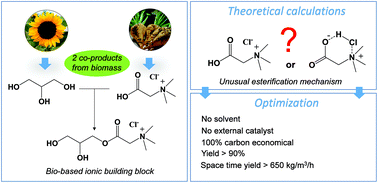当前位置:
X-MOL 学术
›
Green Chem.
›
论文详情
Our official English website, www.x-mol.net, welcomes your
feedback! (Note: you will need to create a separate account there.)
Elucidation of the role of betaine hydrochloride in glycerol esterification: towards bio-based ionic building blocks
Green Chemistry ( IF 9.3 ) Pub Date : 2017-10-18 00:00:00 , DOI: 10.1039/c7gc02767b C. Journoux-Lapp 1, 2, 3, 4 , K. De Oliveira Vigier 1, 2, 3, 4 , C. Bachmann 1, 2, 3, 4 , S. Marinkovic 4, 5, 6, 7 , B. Estrine 4, 5, 6, 7 , G. Frapper 1, 2, 3, 4 , F. Jérôme 1, 2, 3, 4
Green Chemistry ( IF 9.3 ) Pub Date : 2017-10-18 00:00:00 , DOI: 10.1039/c7gc02767b C. Journoux-Lapp 1, 2, 3, 4 , K. De Oliveira Vigier 1, 2, 3, 4 , C. Bachmann 1, 2, 3, 4 , S. Marinkovic 4, 5, 6, 7 , B. Estrine 4, 5, 6, 7 , G. Frapper 1, 2, 3, 4 , F. Jérôme 1, 2, 3, 4
Affiliation

|
The mechanism of bio-based betaine hydrochloride esterification with glycerol has been studied through DFT modelling and experimental approaches. Interestingly, our proposed mechanism differs from the classical Watson and Ingold ones. In particular, we found that the glycine betaine hydrochloride cluster contains a non-dissociated HCl molecule in its structure. This trapped HCl acted as a proton relay to favor the formation of unconstrained six-membered ring transition state structures both in nucleophilic addition (C–O bond coupling) and H2O elimination pathways. These findings led us to optimize this reaction. In particular, glyceryl betaine esters were produced in a yield up to 90% and with a space time yield up to 670 kg m−3 h−1 unreported to date. The absence of an external catalyst and solvent, as well as the use of a stoichiometric mixture of acidified glycine betaine and glycerol, two co-products of the sugar beet and vegetable oil industries, respectively, represent notable advantages within the framework of sustainable chemistry. This work opens a straightforward route to bio-based and valuable ionic building blocks which are of high interest for the synthesis of ionic surfactants or liquids. Furthermore, the results reported in this work also rationalize the high catalytic performances of glycine betaine hydrochloride recently reported in acid-catalyzed reactions.
中文翻译:

阐明甜菜碱盐酸盐在甘油酯化中的作用:朝着基于生物的离子基石的方向发展
通过DFT建模和实验方法研究了生物基甜菜碱盐酸盐与甘油的酯化机理。有趣的是,我们提出的机制与经典的Watson和Ingold有所不同。特别是,我们发现甘氨酸甜菜碱盐酸盐簇在其结构中包含一个未离解的HCl分子。这种截留的HCl充当质子中继,有利于亲核加成(C–O键耦合)和H 2 O消除途径中无约束的六元环过渡态结构的形成。这些发现使我们优化了这一反应。特别地,以高达90%的产率和高达670 kg m -3 h -1的时空产率生产甘油基甜菜碱酯。迄今未报道。甜菜和植物油行业的两种副产品,没有外部催化剂和溶剂,以及使用酸化的甘氨酸甜菜碱和甘油的化学计量混合物,分别代表了可持续化学框架内的显着优势。这项工作为生物基和有价值的离子结构单元开辟了一条简单的途径,这对于合成离子表面活性剂或液体非常重要。此外,这项工作中报道的结果也使最近在酸催化反应中报道的甘氨酸甜菜碱盐酸盐的高催化性能合理化。
更新日期:2017-11-08
中文翻译:

阐明甜菜碱盐酸盐在甘油酯化中的作用:朝着基于生物的离子基石的方向发展
通过DFT建模和实验方法研究了生物基甜菜碱盐酸盐与甘油的酯化机理。有趣的是,我们提出的机制与经典的Watson和Ingold有所不同。特别是,我们发现甘氨酸甜菜碱盐酸盐簇在其结构中包含一个未离解的HCl分子。这种截留的HCl充当质子中继,有利于亲核加成(C–O键耦合)和H 2 O消除途径中无约束的六元环过渡态结构的形成。这些发现使我们优化了这一反应。特别地,以高达90%的产率和高达670 kg m -3 h -1的时空产率生产甘油基甜菜碱酯。迄今未报道。甜菜和植物油行业的两种副产品,没有外部催化剂和溶剂,以及使用酸化的甘氨酸甜菜碱和甘油的化学计量混合物,分别代表了可持续化学框架内的显着优势。这项工作为生物基和有价值的离子结构单元开辟了一条简单的途径,这对于合成离子表面活性剂或液体非常重要。此外,这项工作中报道的结果也使最近在酸催化反应中报道的甘氨酸甜菜碱盐酸盐的高催化性能合理化。











































 京公网安备 11010802027423号
京公网安备 11010802027423号